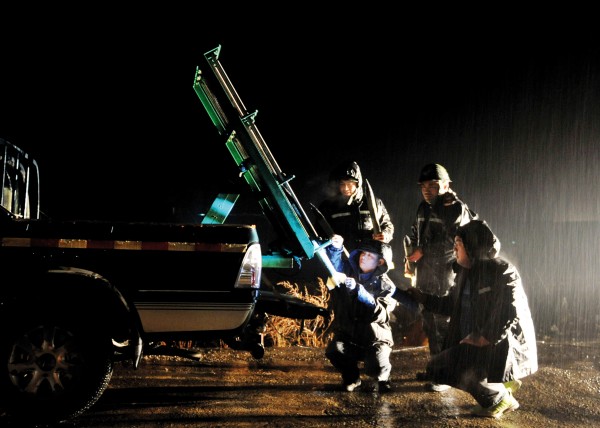Keeping an eye on ice

Twenty-five years ago I sat on a headland above Lake Argentina, in Patagonia, and watched pillars of ice 60 m tall fall off the Perito Moreno Glacier. As one fell only every half-hour or so, I had to be patient. When the moment came, there was a satisfying roar before the pillar crashed into the water and then bounced back up, twisting and breaking into fragments.
The glacier was advancing towards the headland where I was sitting, and was expected to reach it within the year, thereby blocking off a long arm of the lake behind an ice dam. Over a period of seven or eight years the water behind the dam would rise some 30 m until the pressure where ice and lake bed met would be strong enough to force some water out under the glacier.
As it escaped, the water would erode a tunnel through the glacier. The tunnel would steadily grow until its roof caved in, releasing the pent-up water like a dam burst. As the water poured through the hole it would tear the front off the glacier, opening a gap to the headland and sending a huge wave surging down to the far end of the lake, 80 km away.
Once the two parts of the lake were level again and the water had stopped flowing, the glacier would slowly move forward once more, continuing a cycle of advance and retreat that has been going on for centuries.
South of Patagonia, ice on the move in Antarctica has been making headlines recently. According to the United States-based National Snow and Ice Data Centre, 3250 sq km of the Larsen B ice shelf, attached to the Antarctic Peninsula, broke up over a 35-day period beginning on January 31, 2002, setting a plume of thousands of icebergs adrift in the Weddell Sea.
Over the past five years a total of 5700 sq km of the Larsen B ice shelf has broken away, and since 1974 a total of 13,500 sq km has been lost from the seven ice shelves that flank the Antarctic Peninsula. Also this year, a giant iceberg 64 km wide and 85 km long has broken free in the Amundsen Sea, to the west of the Antarctic Peninsula.
All this ice leaving the frozen continent has raised fears of a dramatic rise in sea level. However, since it was already floating, displacing a huge volume of water, its melting won’t affect sea level at all. Nevertheless, the breaking-away of the ice is a sure sign of the rising sea temperatures that have been measured in the area.
A study by Sarah Gille, of the Scripps Institution of Oceanography, published in the magazine Science, has found that temperatures in the upper 1000 m of the Southern Ocean rose by 0.1° C between 1955 and 1995. (This may not seem much of an increase, but it should be remembered that it takes about 4000 times as much energy to heat a cubic metre of water by 1° C as it does to heat a cubic metre of air by the same amount—so even a slight rise in sea temperature represents a considerable amount of extra heat energy in the ocean.) Gille has also found that temperatures at depths of between 700 m and 1100 m in the Antarctic Circumpolar Current (ACC) have risen by 0.17° C over the same period of time.
Studies of below-surface sea temperatures in the Southern Ocean have been hampered in the past by a shortage of shipboard observations. However, in the 1990s new data became available with the release of a number of autonomous floats. These ingenious devices sink to a predetermined depth in the ocean and ride along on the subsurface currents for fixed intervals of 10 to 25 days. They then rise back to the surface and transmit the mean temperature they have recorded during their submergence to a communications satellite.
A typical float rises and falls through 50 cycles over a period of two-and-a-half years. Because the floats drift with the ocean currents they gather data from the entire Southern Ocean. They also operate equally well in winter, when research vessels are generally absent from the area.
More than 50,000 temperature profiles measured since the 1930s by instruments lowered from ships to depths of over 700 m were available to Gille from data archives. She paired off shipboard and float temperatures measured at the same depth at sites within 220 km (two degrees of latitude) of each other. In this way she obtained almost half a million pairs of comparative measurements.
Gille found almost no detectable warming had occurred between the 1930s and 1950s (although few measurements were taken in the 1940s). Warming was most rapid in the 1950s and 1960s, and levelled off in the 1980s and 1990s. Most of the warming occurred between 45° S and 60° S, where the ACC flows, and there were some areas north of 45° S where cooling occurred.
These findings are consistent with a poleward migration of about 50 km by the ACC over the past 70 years, and imply a net warming, and therefore a reduction in volume, of the cold circumpolar waters separating the ACC from the Antarctic continent.
A consequence of this warming is a rise in sea level not because of the melting of floating ice, but because water expands when heated. Indeed, calculations show that expansion of seawater accounts for almost the entire 2-3 mm of annual sea-level rise measured by satellite altimeters.
There is a feedback mechanism for climate change in the warming oceans. Warm water holds less dissolved gas than cold water does, so rising sea temperatures reduce the ocean’s GO, storage capacity.
If ice is leaving the edges of Antarctica, what is happening inland? Most of the ice coming down off the continent of Antarctica moves in the form of giant glaciers known as ice streams, which can flow as fast as 10 m a day. A recent survey of the ice streams feeding the Ross Sea has found evidence that this part of the West Antarctic Ice Sheet is growing.
The gain is occurring mostly in the catchment of an ice stream that seems to have ground to a halt 150 years ago. Two other ice streams are slowing down rapidly and may stop in the not too distant future. Why are the streams stopping? It could be that their behaviour is inherently cyclic, switching between active (“purge”) and inactive (“binge”) phases every thousand years or so. Alternatively, it may be that the retreat of the ice sheet that began with the end of the last ice age has finally come to a halt.
At the planet’s other pole the Greenland Ice Sheet has also been under close scrutiny. Satellite altimeter measurements of ice elevation taken in the mid 1990s have been compared with theodolite measurements taken along a transect across northern Greenland by British scientists during two summers in the early 1950s. Over the intervening 40 years, parts of the eastern side of the ice sheet have increased in thickness by 5-10 m, although a much larger area in the west has decreased by 10-15 m.
At present, the answer to the question of whether Earth’s two main ice sheets are gaining or losing ice depends on where you look. A clearer picture should emerge over the next few decades as the record of satellite altimeter readings grows.
Perhaps no one watches ice as assiduously as folk in Nenana, Alaska—and they’ve been keeping an eye out since 1917. In that year, bored railroad engineers bet on the precise minute the frozen Tenana River would break up. The original pot was $800, but now hundreds of thousands of entrants compete for jackpots exceeding $300,000.
Contest records of the exact minute of ice break-up over the past 84 years can be considered quite accurate, as the high stakes lead to constant vigilance. What does the record tell us? That the spring break-up has become earlier by an average of five-and-a-half days.

















